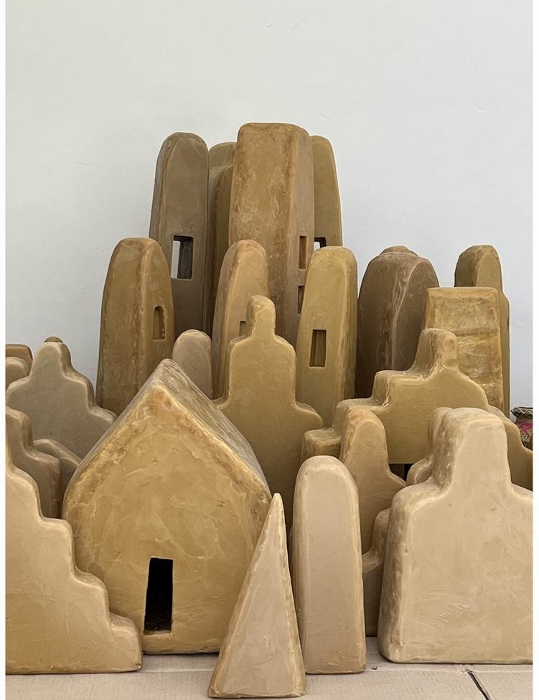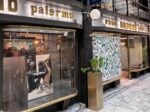Wolfgang Laib – … e vidi cose che ridire né sa né può …

Prima mostra personale dell’artista tedesco Wolfgang Laib nella sede di Milano. Il titolo è tratto da una frase contenuta nella seconda terzina del canto primo del Paradiso di Dante.
Comunicato stampa
La Galleria Lia Rumma inaugura mercoledì 25 ottobre 2023, “...e vidi cose che ridire né sa né può…”, la prima mostra personale dell’artista tedesco Wolfgang Laib nella sede di Milano. Il titolo è tratto da una frase contenuta nella seconda terzina del canto primo del Paradiso di Dante Alighieri, che recita nella versione integrale:
Nel ciel che più de la sua luce prende
fu’ io, e vidi cose che ridire
né sa né può chi di là sù discende
Le pagine di poesia della Divina Commedia, sono l’incipit di Wolfgang Laib per percorrere, come un novello Dante, un altrettanto viaggio ascensionale e spirituale, attraversando diverse forme di ”architetture mentali di luce”. Queste composizioni immateriali rispondono alla costante ricerca di Laib d’intravedere l’universale, l’eterno, in culture e tradizioni diverse del mondo, in pensieri e idee, uguali o simili, che appaiono in luoghi e in tempi diversi. E lo fa servendosi di materiali naturali, perché come lui stesso racconta: ”Quello che mi piace del polline, del latte e della cera d’api è che possono diventare spirituali”.
Il viaggio mistico di Wolfgang Laib si sviluppa sui tre piani della galleria. All’ingresso, a piano terra, s’incontra Zikkurat (2000), un grande ziggurat alto 4 metri completamente rivestito da lastre di cera, che con i suoi gradini, dal basso indica la direzione verso l’alto e verso lo spirituale, dal regno materiale a quello trascendentale. La forma a ziggurat è apparsa per la prima volta nel suo lavoro nel 1995 e si rifà alle antiche strutture religiose della Mesopotamia, visitate durante i suoi tanti viaggi in Medio Oriente.
Salendo al primo piano della galleria l’artista ha collocato City of Silence (2015-2023), un’installazione composta da 34 sculture in cera d’api che evocano paesaggi urbani e motivi architettonici - torri, case e ziggurat - ricorrenti nella narrativa visiva di Laib che traggono ispirazione, tra l’altro, sia dall’architettura dell’Italia medievale che dalle torri del silenzio utilizzate nei riti di scarnificazione zoroastriana nell’antica Persia. È come se l’artista ci consegnasse una sorta di città utopica e ideale di tutti e di nessuno.
Il secondo piano è dedicato al patriarca del buddismo giapponese, Kōbō Daishi: “un monaco giapponese - spiega Laib -, vissuto dal 774 all’835. La sua tomba a Koyasan è uno dei miei posti preferiti in Giappone, collocata alla fine di un cimitero in una foresta di cedri. Dietro il tempio, si trova una piccola struttura in legno con due porte chiuse. Molti pellegrini vi si recano ogni giorno, credendo che il monaco sieda in eterna meditazione dietro quelle porte”. Wolfgang Laib ha realizzato un disegno direttamente sulla parete della galleria, che si rifà all’immagine della tomba di Kōbō Daishi, con al centro le due porte gialle chiuse e circondate da onde bianche, che danno corpo e forma all’energia vitale, quasi un suono, che questo luogo sacro emana. Sulla parete opposta Pollen from Hazelnut (2023), una piccola montagna di polline, altro elemento di natura spirituale, appoggiata su di un piedistallo bianco, fa da contraltare al tempio disegnato, andando al di là del concetto di morte fisica.
In contemporanea alla mostra in Galleria, giovedì 26 ottobre, inaugura la personale di Wolfgang Laib, “Passageway Inside – Downside” a Villa e Collezione Panza – FAI, Varese.
Wolfgang Laib (Metzingen, Germania, 1950), vive e lavora tra il sud della Germania, il sud dell’India e New York. Dopo gli studi in medicina all’Università di Tübingen si dedica alla pratica artistica creando sculture e installazioni che sembrano collegare passato e presente, l'effimero e l'eterno, utilizzando materiali organici semplici ma altamente simbolici, solitamente associati al sostentamento, come polline, latte, cera d'api e riso.
Il suo lavoro è stato presentato a Documenta (1982, 1987) e alla Biennale di Venezia (1997, 1999, 2019), mentre la sua prima grande mostra istituzionale si è tenuta al Musée d'art moderne de la ville de Paris (1986). In seguito è stato protagonista di numerose mostre personali, in particolare all'Hirshhorn Museum and Sculpture Garden di Washington (2002), al Dallas Museum of Art (2002), alla Haus der Kunst di Monaco (2002-03), alla Fondation Beyeler di Basilea (2005-06), alla Fondazione Merz di Torino (2009) e al MMK Museum für Moderne Kunst di Francoforte (2010). La sua più grande opera in polline è stata installata nell'atrio del MoMA di New York nel 2013. Nello stesso anno, la prima installazione permanente dell'artista, una stanza di cera d'api, è stata inaugurata alla Phillips Collection di Washington e nel 2014, ha realizzato una camera permanente sotterranea di cera d'api lunga 40m, nello studio La Ribaute di Anselm Kiefer a Barjac.
Nel 2015 ha ricevuto il Praemium Imperiale a Tokyo. In Italia, a Firenze, nel 2019, il Museo del 900, ha presentato il suo lavoro in diversi siti storici: Convento di San Marco, Cappella Magi in Palazzo Medici-Riccardi, Capella Pazzi in Santa Croce e al Sepolcro Rucellai in San Pancrazio. Nel 2023 il Kunstmuseum Stuttgart gli dedica una personale e presenta in anteprima il documentario “Wolfgang Laib: Here, Now and Far Beyond”.
The Lia Rumma Gallery is pleased to announce the opening on Wednesday 25 October 2023 of “...e vidi cose che ridire né sa né può…”, the first solo exhibition by the German artist Wolfgang Laib in its Milan gallery. The title is taken from a phrase in the second terzina of the first canto of Dante’s Paradiso which reads as follows in the complete version:
Within that heaven which most his light receives
Was I, and things beheld which to repeat
Nor knows, nor can, who from above descends
The poetry of the Divine Comedy provides the starting point for Wolfgang Laib to embark, like a latter-day Dante, on an equally upward and spiritual journey, through various forms of “mental architectures of light”. These immaterial compositions are the result of Laib’s unceasing quest to get a glimpse of the universal and eternity in various cultures and traditions of the world, in the form of identical or similar thoughts and ideas that have appeared in different places and eras. Laib does this by making use of natural materials because, as the artist himself recounts, “What I like about pollen, milk and beeswax is that they can become spiritual entities”.
Wolfgang Laib’s mystic journey unfolds on the three floors of the gallery. At the entrance, on the ground floor, visitors encounter Zikkurat (2000), a large ziggurat 4 metres high, completely covered in slabs of wax, which, with its steps, from the bottom indicates the direction towards the lofty heights and the spiritual realm, from the material world to the transcendental world. The form of the ziggurat appeared for the first time in his work in 1995 and draws on the ancient religious structures of Mesopotamia, which he visited during his extensive travels in the Middle East.
Moving up to the first floor of the gallery, the artist has positioned City of Silence (2015-2023), an installation consisting of 34 sculptures in beeswax that evoke urban landscapes and architectural motifs - towers, houses and ziggurats – recurrent features of Laib’s visual narrative which are also inspired both by the architecture of medieval Italy and the towers of silence used in the rites of Zoroastrian excarnation in ancient Persia. It is as if the artist were handing us a sort of utopian, ideal city that belongs to everyone and no one.
The second floor is devoted to the patriarch of Japanese Buddhism, Kōbō Daishi: “a Japanese monk,” explains Laib, “who lived from AD 774 to AD 835. His tomb in Koyasan is one of my favourite places in Japan, situated at the end of a cemetery in a cedar forest. Behind the temple, there is a small wooden structure with two closed doors. Many pilgrims go there every day in the belief that the monk sits in a state of eternal meditation behind the doors”. Wolfgang Laib has done a drawing directly on the walls of the gallery which depicts the tomb of Kōbō Daishi, with two closed yellow doors at the centre, surrounded by white waves which give substance and form to the life force, almost a sound that emanates from this sacred site. On the opposite wall, Pollen from Hazelnut (2023), a small mountain of pollen, another element of spiritual energy, resting on a white pedestal, acts as a counter-attraction to the drawing of the temple, going beyond the concept of physical death.
In conjunction with the Gallery exhibition, Wolfgang Laib's solo exhibition, "Passageway Inside - Downside" opens at Villa and Collection Panza - FAI, Varese, on Thursday, Oct. 26.
Wolfgang Laib (Metzingen, Germany, 1950), lives and works between southern Germany, southern India and New York. After studying medicine at the University of Tubingen, he devoted himself to artistic practice, creating sculptures and installations that appear to link past and present, the ephemeral and the eternal, using simple but highly symbolic organic materials, usually associated with nourishment, such as pollen, milk, beeswax and rice.
His work has been presented at Documenta (1982, 1987) and at the Venice Biennale (1997, 1999, 2019), while his first major institutional exhibition was held in the Musée d'art moderne de la ville in Paris (1986). Numerous solo exhibitions were subsequently devoted to his work, in particular at the Hirshhorn Museum and Sculpture Garden in Washington (2002), the Dallas Museum of Art (2002), the Haus der Kunst in Munich (2002-03), the Fondation Beyeler in Basel (2005-06), the Fondazione Merz in Turin (2009) and at the MMK Museum für Moderne Kunst in Frankfurt (2010). His largest work in pollen was installed in the atrium of MoMA in New York in 2013. In the same year, the artist’s first permanent installation, a room of beeswax, was opened in the Phillips Collection in Washington and in 2014, he created a permanent underground chamber of beeswax 40 metres long in La Ribaute Anselm Kiefer’s studio complex in Barjac.
In 2015 he was awarded the Praemium Imperiale at Tokyo. In Italy, the Museo Novecento presented his works in various historical sites in Florence in 2019: the monastery of San Marco, the Chapel of the Magi in Palazzo Medici-Riccardi, the Pazzi Chapel in the church of Santa Croce and at the Rucellai Sepulchre in San Pancrazio. In 2023 the Kunstmuseum Stuttgart devoted a solo exhibition to the artist’s work and presented the premiere of the documentary “Wolfgang Laib: Here, Now and Far Beyond”.



